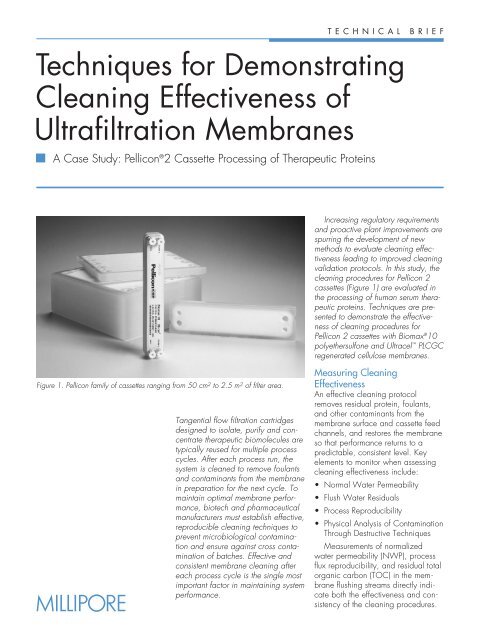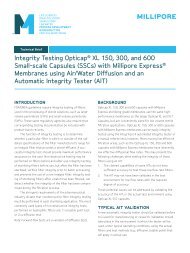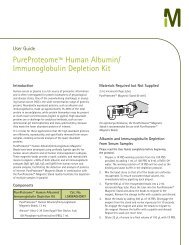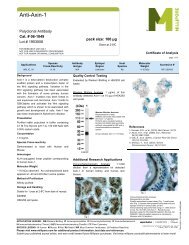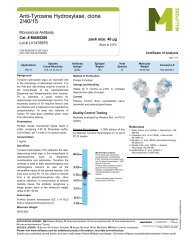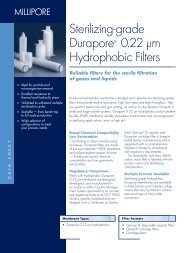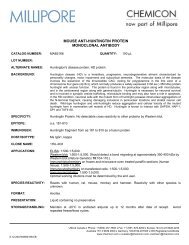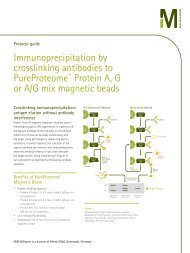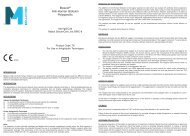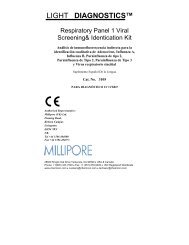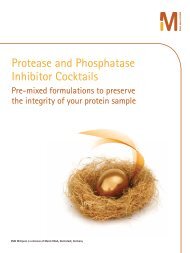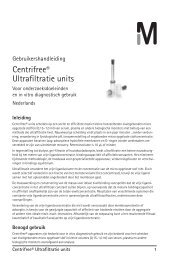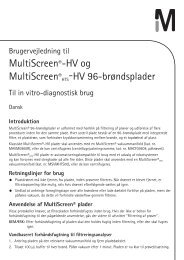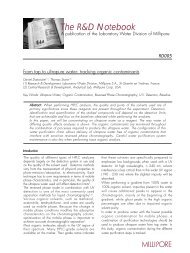*00-237 Cleaning Tech Brief - Millipore
*00-237 Cleaning Tech Brief - Millipore
*00-237 Cleaning Tech Brief - Millipore
You also want an ePaper? Increase the reach of your titles
YUMPU automatically turns print PDFs into web optimized ePapers that Google loves.
Tangential flow filtration cartridges<br />
designed to isolate, purify and concentrate<br />
therapeutic biomolecules are<br />
typically reused for multiple process<br />
cycles. After each process run, the<br />
system is cleaned to remove foulants<br />
and contaminants from the membrane<br />
in preparation for the next cycle. To<br />
maintain optimal membrane performance,<br />
biotech and pharmaceutical<br />
manufacturers must establish effective,<br />
reproducible cleaning techniques to<br />
prevent microbiological contamination<br />
and ensure against cross contamination<br />
of batches. Effective and<br />
consistent membrane cleaning after<br />
each process cycle is the single most<br />
important factor in maintaining system<br />
performance.<br />
TECHNICAL BRIEF<br />
<strong>Tech</strong>niques for Demonstrating<br />
<strong>Cleaning</strong> Effectiveness of<br />
Ultrafiltration Membranes<br />
A Case Study: Pellicon ® 2 Cassette Processing of Therapeutic Proteins<br />
Figure 1. Pellicon family of cassettes ranging from 50 cm 2 to 2.5 m 2 of filter area.<br />
Â<br />
Increasing regulatory requirements<br />
and proactive plant improvements are<br />
spurring the development of new<br />
methods to evaluate cleaning effectiveness<br />
leading to improved cleaning<br />
validation protocols. In this study, the<br />
cleaning procedures for Pellicon 2<br />
cassettes (Figure 1) are evaluated in<br />
the processing of human serum therapeutic<br />
proteins. <strong>Tech</strong>niques are presented<br />
to demonstrate the effectiveness<br />
of cleaning procedures for<br />
Pellicon 2 cassettes with Biomax ® 10<br />
polyethersulfone and Ultracel PLCGC<br />
regenerated cellulose membranes.<br />
Measuring <strong>Cleaning</strong><br />
Effectiveness<br />
An effective cleaning protocol<br />
removes residual protein, foulants,<br />
and other contaminants from the<br />
membrane surface and cassette feed<br />
channels, and restores the membrane<br />
so that performance returns to a<br />
predictable, consistent level. Key<br />
elements to monitor when assessing<br />
cleaning effectiveness include:<br />
• Normal Water Permeability<br />
• Flush Water Residuals<br />
• Process Reproducibility<br />
• Physical Analysis of Contamination<br />
Through Destructive <strong>Tech</strong>niques<br />
Measurements of normalized<br />
water permeability (NWP), process<br />
flux reproducibility, and residual total<br />
organic carbon (TOC) in the membrane<br />
flushing streams directly indicate<br />
both the effectiveness and consistency<br />
of the cleaning procedures.
Visual assessment and Fourier Transform<br />
Infrared Spectroscopy (FTIR)<br />
analysis of the membrane surface<br />
are destructive tests that may be<br />
used during the development phase<br />
to evaluate the membrane and<br />
device after cleaning.<br />
Selection of cleaning chemicals,<br />
flow and pressure conditions, cycle<br />
times and cleaning sequences are<br />
key elements in a cleaning protocol.<br />
Guidelines and process conditions are<br />
specific for the membrane type, device<br />
configuration, and process fluid, and<br />
are provided in Instruction Manuals for<br />
specific <strong>Millipore</strong> products. For<br />
Pellicon products refer to:<br />
Pellicon 2 Instruction Manual P35472<br />
Pellicon XL Instruction Manual P60085<br />
Normal Water Permeability<br />
(NWP)<br />
Normalized water permeability<br />
(NWP) is an established method<br />
for determining the cleanliness of a<br />
cassette after cleaning. This method<br />
involves measuring the passage of<br />
clean water through the membrane<br />
under standard pressure and temperature<br />
conditions (Figure 2). The rate<br />
of clean water flux through the membrane<br />
is measured as liters per membrane<br />
area per hour (L/m 2 -h). Water<br />
flux divided by the transmembrane<br />
pressure is the normal water permeability<br />
or NWP (L/m 2 -h-bar). The<br />
NWP values are compared to initial<br />
(pre-process) levels and may be<br />
analyzed for trends over time.<br />
Fouled membranes typically have<br />
NWP values that are significantly<br />
less than 50% of the membrane’s<br />
original NWP specification because<br />
of adsorption of materials such as<br />
proteins on the membrane surface.<br />
<strong>Cleaning</strong> cycles remove these foulants<br />
by oxidizing, emulsifying and removing<br />
the foulants from the membrane<br />
surface. After cleaning, if the membrane<br />
NWP is ±20% of the pre-run<br />
NWP value, process stream reproducibility<br />
will result. The acceptance<br />
criterion for cleaning efficacy is<br />
membrane and application specific,<br />
and may vary between plants.<br />
The procedures for measuring<br />
NWP are:<br />
• Fill tank with clean water<br />
• Set standard conditions<br />
• Record water permeability rates,<br />
pressure, and temperature<br />
TOC as a Measurement of<br />
Flushing Effectiveness<br />
In commercial (TFF) applications,<br />
the membrane cassette and system are<br />
flushed to displace storage and cleaning<br />
solutions, and to remove residual<br />
process materials. TOC measurements<br />
of the permeate and retentate flush<br />
streams provide a reliable and highly<br />
sensitive means of detecting organic<br />
contamination in a cassette (Figure 3).<br />
Because of its sensitivity, TOC is<br />
becoming the preferred method for<br />
identifying contamination from inade-<br />
Feed Tank<br />
Pump Pellicon<br />
Cassette<br />
quate cleaning protocols, product<br />
carryover between batches, and crosscontamination<br />
of products exposed to<br />
the same process equipment. The flush<br />
cycle performed immediately prior to<br />
the process feed is termed the “critical<br />
flush” and is the most important cycle<br />
to identify trace contaminants using the<br />
TOC analysis. Typical TFF system<br />
critical flush volumes of 20 L/m2 of<br />
membrane are used and should yield<br />
TOC values below a 1.0 ppm level.<br />
The procedures are summarized as<br />
follows:<br />
• Fill clean tank with water-for-injection<br />
(WFI)<br />
• Divert permeate and retentate lines<br />
• Set standard flush conditions<br />
• Sample flush water over time<br />
• Measure TOC<br />
Standard Pressure<br />
and Temperature<br />
(1 bar, 25 °C)<br />
Measure<br />
Permeate<br />
Rate<br />
Figure 2. Generalized process schematic to measure Normal Water Permeability (NWP).<br />
Feed Tank<br />
Pump<br />
Pellicon<br />
Cassette<br />
Collect samples at<br />
various time<br />
intervals.<br />
Permeate<br />
TOC<br />
Retentate<br />
TOC<br />
Figure 3. Generalized schematic for collecting samples to measure TOC during the<br />
critical flush cycle.
Demonstrating <strong>Cleaning</strong> Effectiveness in a TFF System<br />
Case Study:<br />
Multiple Process<br />
& <strong>Cleaning</strong> Cycles<br />
Process Run to<br />
Concentrate Protein<br />
<strong>Cleaning</strong><br />
Regime<br />
Critical<br />
Flush<br />
NWP<br />
Measurement<br />
Experimental <strong>Tech</strong>nique<br />
Pellicon 2 cassettes were subjected<br />
to multiple processing and cleaning<br />
cycles on a human serum albumin<br />
(HSA) feed solution concentrating<br />
from 2% to 25% protein and in<br />
separate tests with a solution of<br />
8% Fraction 1 protein. Biomax 10<br />
(polyethersulfone) and Ultracel<br />
PLCGC (regenerated cellulose)<br />
membranes were chosen to repre-<br />
Look for Consistent &<br />
Reproducible Results<br />
• Process Flux<br />
• Pressure Profiles<br />
• Retention<br />
• Product Yield<br />
• <strong>Cleaning</strong><br />
• Chemical Usage<br />
• Cycle Times<br />
• Pressure Profiles<br />
TOC Residuals in<br />
Permeate and<br />
Retentate<br />
Flush Water<br />
Reproducible<br />
NWP within<br />
20% of<br />
Pre-Process NWP<br />
Analyze Trends for<br />
Corrective Action<br />
Figure 4. Key elements demonstrating cleaning effectiveness in a TFF system.<br />
Feed Tank<br />
Pump<br />
Back Pressure<br />
Valve<br />
sent two different membrane formulations.<br />
Membranes were exposed<br />
to identical process environments<br />
under production-scale conditions to<br />
compare performance and demonstrate<br />
applicability.<br />
Multiple 2-hour concentration<br />
cycles established process reproducibility.<br />
Worst-case conditions<br />
were simulated during extended<br />
process cycles (up to 19.5 hours)<br />
at the maximum commercial protein<br />
concentration.<br />
Retentate<br />
Cartridge<br />
Figure 5. Generalized pilot schematic for HSA cleaning trials.<br />
Permeate<br />
(Filtrate)<br />
Process Reproducibility<br />
The goal of a cleaning cycle is to<br />
ensure consistent process performance<br />
on a product stream. Reproducible<br />
process flux and predictable<br />
product yield are directly related to<br />
membrane cleaning. Long-term monitoring<br />
of the process and cleaning<br />
performance provides a means to<br />
proactively address potential operating<br />
problems and enhances overall<br />
process consistency.<br />
Examination for Physical<br />
Evidence of Foulants<br />
After many process cycles, the feed<br />
screen and membrane surface can<br />
be examined for residual protein by<br />
autopsying the cassette to determine<br />
cleaning effectiveness. The surface of<br />
the cleaned membrane may also be<br />
analyzed by high resolution FTIR<br />
spectrum for evidence of protein<br />
foulants and compared to the FTIR<br />
of an unused membrane sample.<br />
This procedure is a destructive technique<br />
that may be used to assist in<br />
validating a cleaning protocol.<br />
After processing, membrane<br />
cassettes were flushed with 1%<br />
NaCl at 10 °C and cleaned independently<br />
according to membrane<br />
type: Biomax membranes were<br />
cleaned with a caustic/chlorine<br />
procedure (0.25N NaOH, 250<br />
ppm sodium hypochlorite;) and<br />
Ultracel membranes were cleaned<br />
with a caustic-only (0.25N NaOH)<br />
procedure. The duration of both<br />
membrane cleaning cycles was<br />
1hour at 40 °C. Operating conditions<br />
were 2.0/0.5 bar with a<br />
crossflow of 6 Lpm/m2 . Following<br />
each cleaning cycle, WFI flush water<br />
TOC levels were tracked in the<br />
permeate and retentate lines, and<br />
NWP was measured at standard<br />
conditions. The key elements in operation<br />
of the pilot system were to:<br />
• Match process-scale conditions<br />
• Perform multiple process runs<br />
• Compare flux performance<br />
• Concentrate to maximum levels
Case Study: Results<br />
Consistent Return of Water<br />
Permeability<br />
Membrane cleaning procedures<br />
effectively restored NWP following<br />
each process trial. When compared<br />
to “Pre-Run” NWP, the combined<br />
caustic and hypochlorite regime for<br />
the Biomax membrane and the caustic-only<br />
cleaning for the Ultracel<br />
returned NWP values to near-initial<br />
levels. The lower NWP values of the<br />
Ultracel membrane compared to<br />
Biomax is an inherent membrane trait<br />
related to membrane composition<br />
and is not indicative of process flux.<br />
Consistent Process Performance<br />
Both the Biomax and Ultracel membranes<br />
demonstrated reproducible<br />
and predictable flux in all trials.<br />
Ultracel flux was stable at high protein<br />
concentrations during extended<br />
runs, demonstrating the low fouling<br />
nature of the regenerated cellulose<br />
membrane. Stable process pressures<br />
and flow conditions indicate<br />
absence of plugging and suitability<br />
of cassette design.<br />
No Protein Loss<br />
Samples of composite permeate<br />
from each process run were analyzed<br />
for protein using the biuret<br />
method. No protein loss was<br />
detected in the permeate, indicating<br />
greater than 99.9% protein yield.<br />
Water Permeability After <strong>Cleaning</strong><br />
Sequential Process Runs<br />
Flux (lmh-bar at 15 °C)<br />
250<br />
200<br />
150<br />
100<br />
50<br />
0<br />
Pre<br />
Run<br />
1<br />
2 3 4<br />
Post-Run<br />
5<br />
6<br />
Biomax 10<br />
Biomax 10<br />
7 8<br />
Human Serum Albumin Performance<br />
Biomax 10 and Ultracel PLCGC Cassettes<br />
Flux (lmh)<br />
100<br />
10<br />
1<br />
1 2<br />
Run<br />
3 4 5<br />
HSA Permeate Composite Loss<br />
(% w/v)<br />
Run Number Ultracel PLCGC Biomax 10<br />
1 0.00 0.01<br />
2 0.00 0.00<br />
3 0.00 0.00<br />
4 0.00 0.00<br />
5 0.00 0.00<br />
6 0.00 0.00<br />
7 – 0.00<br />
8 – 0.00<br />
9 – 0.00<br />
6<br />
9<br />
Pre<br />
Run<br />
1<br />
Post-Run<br />
2 3 4 5 6<br />
Ultracel PLCGC<br />
Membrane Type<br />
Flux at 10% HSA<br />
7 9 1<br />
2<br />
8<br />
3 4<br />
Run<br />
5<br />
6<br />
7 8<br />
7 8<br />
Ultracel PLCGC<br />
Membrane Type<br />
9
Case Study: Results<br />
Low Protein Carryover<br />
After Flushing<br />
Residual protein carryover between<br />
process runs is readily detected by<br />
TOC analysis of the flush waters.<br />
Cassettes of both membranes demonstrated<br />
efficient flushing to less than<br />
500 parts per billion (ppb) TOC at<br />
flush volumes of 10 to 20 L/m 2 of<br />
membrane area.<br />
Flushing Efficiency of Biomax 10 Cassettes<br />
TOC (ppb)<br />
TOC (ppb)<br />
350<br />
300<br />
250<br />
200<br />
150<br />
100<br />
50<br />
0<br />
500<br />
400<br />
300<br />
200<br />
100<br />
0<br />
0<br />
0<br />
Average of All Runs<br />
Flush Water Volume (L/m2 20 40 60 80<br />
)<br />
Flushing Efficiency of Ultracel PLCGC Cassettes<br />
800<br />
700<br />
600<br />
Permeate<br />
Retentate<br />
Permeate<br />
Retentate<br />
Flush Volume (L/m2 10 20 30 40 50 60 70 80<br />
)<br />
100<br />
90
Case Study: Results<br />
No Adsorptive Fouling on<br />
Ultracel Membrane<br />
After multiple process cycles, an<br />
autopsy revealed no visible foulants<br />
or protein material in the cleaned<br />
Ultracel membrane cassette. Comparing<br />
the FTIR spectrum to that of<br />
a new membrane confirmed the<br />
absence of protein on the cleaned<br />
Ultracel membrane surface.<br />
<strong>Cleaning</strong> Results<br />
• Both membrane types show<br />
return of NWP to original values<br />
• Complete restoration of process<br />
flux<br />
• Flushing studies show low residual<br />
protein<br />
• FTIR shows no adsorption on<br />
Ultracel membrane<br />
FTIR Analysis of the Ultracel PLCGC Membrane Surface<br />
After Fraction 1 Processing<br />
PLCGC membrane repeatedly<br />
exposed to albumin and cleaning<br />
PL-Regenerated cellulose control<br />
3500 3000 2500 2000 1500 1000<br />
Wave Numbers (cm-1)
Case Study: Results<br />
Residual TOC in a New Membrane<br />
Pellicon cassettes are shipped with<br />
storage preservative to prevent<br />
microorganism growth and to maintain<br />
membrane performance specifications.<br />
The TOC test allows for a<br />
simple technique to verify removal of<br />
Sequential WFI “Critical Flush” Cycles<br />
New<br />
Cassette<br />
Initial WFI<br />
Flush<br />
Standard<br />
<strong>Cleaning</strong><br />
Cycle<br />
the organic based preservative. To<br />
remove the preservative, new cassettes<br />
were clean-water flushed with<br />
permeate and retentate directed to<br />
drain. Measurement of permeate<br />
and retentate TOC residuals of a<br />
new cassette and successive flushes<br />
(indicated as 1-4 in figure 6)<br />
WFI<br />
Flush<br />
Standard<br />
<strong>Cleaning</strong><br />
Cycle<br />
WFI<br />
Flush<br />
demonstrated the removal of residual<br />
TOC to below 1.0 ppm after<br />
the first flush using 20 L/m 2 of WFI<br />
flush water. Repeated cleaning and<br />
flush cycles show some additional<br />
removal of TOC down to the<br />
200 ppb level.<br />
Flush 1 Flush 2 Flush 3 Flush 4<br />
Figure 6. Experimental Sequence For New Membrane Flushing Trials<br />
New Cassette Flushing Efficiency<br />
TOC(ppb)<br />
5000<br />
4500<br />
4000<br />
3500<br />
CIP<br />
Retentate<br />
Permeate<br />
3000 WFI Flush Volume: 20 L/m 2<br />
2500<br />
2000<br />
1500<br />
1000<br />
500<br />
0<br />
New Cassette<br />
Initial Flush<br />
Pellicon Ultracel Cassette PLCGC<br />
CIP CIP<br />
Flush 1 Flush 2 Flush 3 Flush 4<br />
Sequential WFI “Critical Flush” Cycles<br />
Standard<br />
<strong>Cleaning</strong><br />
Cycle<br />
WFI<br />
Flush
Membrane Selection<br />
Pellicon 2 cassettes with either<br />
Biomax 10 or Ultracel PLCGC membranes<br />
demonstrate process consistency<br />
and reproducible cleanability.<br />
Both types are the latest generation<br />
of void-free, controlled pore membranes<br />
designed for high flux and<br />
excellent product retention. Membrane<br />
selection may be based on preference<br />
for a specific chemical cleaning<br />
procedure, membrane type, or other<br />
process attribute.<br />
The techniques used for evaluating<br />
cassette cleanability may be extended<br />
to other <strong>Millipore</strong> tangential flow<br />
products when there is a need to<br />
demonstrate process consistency and<br />
reproducible cleanability with membrane-specific<br />
cleaning procedures.<br />
Ask your <strong>Millipore</strong> Applications<br />
Specialist for additional guidance<br />
on cleaning optimization, enhancing<br />
yields and improving membrane<br />
performance.<br />
To Place an Order or Receive<br />
<strong>Tech</strong>nical Assistance<br />
For additional information call your<br />
nearest <strong>Millipore</strong> office:<br />
In the U.S. and Canada,<br />
call toll-free 1-800-MILLIPORE<br />
(1-800-645-5476)<br />
In the U.S., Canada and Puerto<br />
Rico, fax orders to 1-800-MILLIFX<br />
(1-800-645-5439)<br />
On the Internet<br />
http://www.millipore.com<br />
E-mail: tech_service@millipore.com<br />
Â<br />
Ultracel is a trademark of <strong>Millipore</strong> Corporation or<br />
an affiliated company.<br />
Pellicon, Biomax and <strong>Millipore</strong> are trademarks of<br />
<strong>Millipore</strong> Corporation or an affiliated company.<br />
Triton is a trademark of Rohm and Haas Company.<br />
Lit. No. TB1502EN00<br />
Printed in U.S.A. 12/00 00-<strong>237</strong><br />
© 2000 <strong>Millipore</strong> Corporation or an affiliated<br />
company, Bedford, MA. All rights reserved.<br />
Membrane Type Biomax 10 Ultracel<br />
Membrane Polyethersulfone Regenerated cellulose<br />
Molecular weight cut-off 5 kd – 1000 kd 1 kd – 1000 kd<br />
Relative protein binding Low to medium, use with Ultra-low, far superior for use<br />
>0.1 mg/mL protein solutions with dilute protein solutions<br />
pH range 1 – 14 2 – 13<br />
Chemical compatibility 250 ppm sodium hypochlorite Use with anti-foams<br />
resists organic solvents<br />
<strong>Cleaning</strong> Easy to clean Easy to Clean<br />
Common attributes Excellent protein retention<br />
High process flux<br />
Long membrane life<br />
<strong>Millipore</strong> Worldwide<br />
AUSTRALIA<br />
Tel. 1 800 222 111<br />
or (02) 9888 8999<br />
Fax (02) 9878 0788<br />
AUSTRIA<br />
Tel. (01) 877-8926<br />
Fax (01) 877-1654<br />
BALTIC COUNTRIES<br />
Tel. +358 9 804 5110<br />
Fax +358 9 256 5660<br />
BELGIUM AND<br />
LUXEMBOURG<br />
Tel. (02) 726 88 40<br />
Fax (02) 726 98 84<br />
BRAZIL<br />
Tel. (011) 5548-7011<br />
Fax (011) 5548-7923<br />
CANADA<br />
Tel. 1-800-645-5476<br />
Fax 1-800-645-5439<br />
CHINA, PEOPLE'S<br />
REPUBLIC OF<br />
Beijing:<br />
Tel. (8610) 8519-1250<br />
(8610) 8519-1058<br />
Fax (8610) 8519-1255<br />
Guangzhou:<br />
Tel. (8620) 8755-4021<br />
Fax (8620) 8755-4350<br />
Hong Kong:<br />
Tel. (852) 2803-9111<br />
Fax (852) 2513-0313<br />
Shanghai:<br />
Tel. (8621) 5306-9100<br />
Fax (8621) 5306-0838<br />
CZECH REPUBLIC<br />
Tel. 02-2051 3841<br />
02-2051 3842<br />
Fax 02-2051 4298<br />
DENMARK<br />
Tel. 70 10 00 23<br />
Fax 70 10 13 14<br />
EASTERN EUROPE, C.I.S.,<br />
AFRICA, MIDDLE EAST<br />
AND GULF<br />
Tel. (43) 1 877-8926<br />
Fax (43) 1 877-1654<br />
FINLAND<br />
Tel. (09) 804 5110<br />
Fax (09) 256 5660<br />
FRANCE<br />
Tel. (01) 30.12.70.00<br />
Fax (01) 30.12.71.80<br />
GERMANY<br />
Tel. (06196) 494-0<br />
Fax (06196) 43901<br />
HUNGARY<br />
Tel. 1-205 9784<br />
Fax 1-205 9792<br />
INDIA<br />
Tel. (91) 80-839 46 57<br />
Fax (91) 80-839 63 45<br />
ITALY<br />
Vimodrone (Milano):<br />
Tel. (02) 25.07.81<br />
Fax (02) 26.50.324<br />
Roma:<br />
Tel. (06) 52.03.600<br />
Fax (06) 52.95.735<br />
JAPAN<br />
Tel. (03) 5442-9711<br />
Fax (03) 5442-9736<br />
KOREA<br />
Tel. (822) 551-0990<br />
Fax (822) 551-0228<br />
MALAYSIA<br />
Tel. 603-757 1322<br />
Fax 603-757 1711<br />
MEXICO<br />
Tel. (525) 576-9688<br />
Fax (525) 576-8706<br />
THE NETHERLANDS<br />
Tel. 076-5022000<br />
Fax 076-5022436<br />
NORWAY<br />
Tel. 22 67 82 53<br />
Fax 22 66 04 60<br />
POLAND<br />
Tel. 22-669 12 25<br />
22-663 70 31<br />
Fax 22-663 70 33<br />
PUERTO RICO<br />
Tel. (787) 273-8495<br />
Fax (787) 747-6553<br />
SINGAPORE<br />
Tel. (65) 842 1822<br />
Fax (65) 842 4988<br />
SPAIN AND PORTUGAL<br />
Madrid:<br />
Tel. 917 283 960<br />
Fax 917 292 909<br />
Barcelona:<br />
Tel. 934 525 530<br />
Fax 934 516 048<br />
SWEDEN<br />
Tel. 08-628 6960<br />
Fax 08-628 6457<br />
SWITZERLAND<br />
Volketswil:<br />
Tel. (01) 908-30-60<br />
Fax (01) 908-30-80<br />
Lausanne:<br />
Tel. (021) 641 2550<br />
Fax (021) 641 2551<br />
TAIWAN<br />
Taipei:<br />
Tel. (886-2) 700-1742<br />
Fax (886-2) 755-3267<br />
Hsin Chu City:<br />
Tel. (886-3) 571-0178<br />
Fax (886-3) 572-9520<br />
U.K. AND IRELAND<br />
Tel. (01923) 816375<br />
Fax (01923) 818297<br />
U.S.A.<br />
Tel. (781) 533-6000<br />
Fax (781) 533-3110<br />
IN ALL OTHER<br />
COUNTRIES<br />
<strong>Millipore</strong> Intertech (U.S.A.)<br />
Tel. +1 (781) 533-8622<br />
Fax +1 (781) 533-8630


